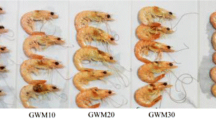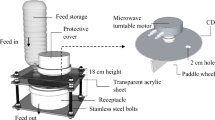Abstract
Jellyfish are sometimes considered as valueless because of their supposed low nutritive content. Here, we conducted feeding experiments on silver pomfret juveniles to evaluate the dietary value of jellyfish. Six treatments, including a starvation treatment (S) and five feeding treatments, with Aurelia aurita (AA), Rhopilema esculentum (RE), artificial diet (AD), both A. aurita and artificial diet (A&A), and both R. esculentum and artificial diet (R&A), were carried out to compare fish survival rates and growth performance. Fish with S treatment showed a 48% mortality rate and reduced body weight, whereas fish with AA and RE treatments showed no death and much increased body weight. Fish with A&A and R&A treatments exhibited a much faster growth than that with AD treatment. Further, the effects of diet on biochemical composition of silver pomfrets were explored. Monounsaturated fatty acid (MUFA), seven different fatty acids, and six different essential amino acids (EAAs) were showed to be good indicators to assess silver pomfrets’ response to their prey. Our experiment indicated that the jellyfish, A. aurita and R. esculentum, can provide energy for silver pomfrets’ metabolism and growth, and as supplemental food are suitable for rearing silver pomfret juveniles.

Similar content being viewed by others
References
Arai, M. N., 2001. Pelagic coelenterates and eutrophication: a review. Hydrobiologia 451: 69–87.
Arai, M. N., 2005. Predation on pelagic coelenterates: a review. Journal of the Marine Biological Association of the United Kingdom 85(03): 523–536.
Arai, M. N., D. W. Welch, A. L. Dunsmuir, M. C. Jacobs & A. R. Ladouceur, 2003. Digestion of pelagic Ctenophora and Cnidaria by fish. Canadian Journal of Fisheries and Aquatic Sciences 60(7): 825–829.
Aral, M. N., J. A. Ford & J. N. C. Whyte, 1989. Biochemical composition of fed and starved Aequorea Victoria (Murbach et Shearer, 1902) (Hydromedusa). Journal of Experimental Marine Biology and Ecology 127(3): 289–299.
Ates, R. M. L., 1991. Predation on Cnidaria by vertebrates other than fishes. Hydrobiologia 216(217): 305–307.
Brotz, L., W. W. L. Cheung, K. Kleisner, E. Pakhomov & D. Pauly, 2012. Increasing jellyfish populations: trends in Large Marine Ecosystems. Hydrobiologia 690(1): 3–20.
Condon, R. H., C. M. Duarte, K. A. Pitt, K. L. Robinson, C. H. Lucas, K. R. Sutherland, H. W. Mianzan, M. Bogeberg, J. E. Purcell, M. B. Decker, S. Uye, L. P. Madin, R. D. Brodeur, S. H. D. Haddock, A. Malej, G. D. Parry, E. Eriksen, J. Quiñones, M. Acha, M. Harvey, J. M. Arthur & W. M. Graham, 2013. Recurrent jellyfish blooms are a consequence of global oscillations. Proceedings of the National Academy of Sciences 110(3): 1000–1005.
Cheng, Y. X., N. S. Du & W. Lai, 1998. Lipid composition in hepatopancreas of Chinese mitten crab Eriocheir sinensis at different stages. Acta Zoologica Sinica 44(4): 420–429.
Chopra, S., 1960. A note on the sudden outburst of ctenophores and medusae in the waters off Bombay. Current Science 29: 392–393.
Conceicão, L. E. C., H. Grasdalen & I. Rønnestad, 2003. Amino acid requirements of fish larvae and post-larvae: new tools and recent findings. Aquaculture 227: 221–232.
Davis, P. & A. Wheeler, 1985. The occurrence of Pampus argenteus (Euphrasen, 1788), (Osteichthyes, Perciformes, Stromateiodei, Stromateidae) in the North Sea. Journal of Fish Biology 26(2): 105–109.
Dong, Z., D. Liu & J. K. Keesing, 2010. Jellyfish blooms in China: dominant species, causes and consequences. Marine Pollution Bulletin 60(7): 954–963.
Folch, J., M. Lees & G. H. S. Stanley, 1957. A simple method for the isolation and purification of total lipids from animal tissues. Journal of Biological Chemistry 226: 497–509.
Fukuda, Y. & T. Naganuma, 2011. Potential dietary effects on the fatty acid composition of the common jellyfish Aurelia aurita. Marine Biology 138(5): 1029–1035.
Gong, Q. X., N. L. P. He & C. J. Zheng, 1989. On the change of the ovary in annual cycle of silver pomfret Pampus argenteus from the East China Sea. Journal of Fisheries of China 13(4): 316–325. (in Chinese with English abstract).
Graeve, M., G. Kattner & W. Hagen, 1994. Diet-induced changes in the fatty acid composition of Arctic herbivorous copepods: experimental evidence of trophic markers. Journal of Experimental Marine Biology and Ecology 182(1): 97–110.
Grigorakis, K., 2007. Compositional and organoleptic quality of farmed and wild gilthead sea bream (Sparus aurata) and sea bass (Dicentrarchus labrax) and factors affecting it: a review. Aquaculture 272: 55–75.
Harris, L. G., 1987. Aeolid nudibranchs as predators and prey. American Malacological Bulletin 5: 287–292.
Holland, D., J. Davenport & J. East, 1990. The fatty acid composition of the leatherback turtle Dermochelys coriacea and its jellyfish prey. Journal of the Marine Biological Association of the United Kingdom 70: 761–770.
Horwutz, W., 2000. Official Methods of Analysis of AOAC International, 17th edn, vol. 1. AOAC International, Gaithersburg, MD.
Hsieh, Y. H. P., F. M. Leong & J. Rudloe, 2001. Jellyfish as food. Hydrobiologia 451(1–3): 11–17.
Larson, R. J., 1986. Water content, organic content, and carbon and nitrogen composition of medusae from the northeast Pacific. Journal of Experimental Marine Biology and Ecology 99(2): 107–120.
Liu, C. S., Z. M. Zhuang, S. Q. Chen, Z. H. Shi, J. P. Yan & C. L. Liu, 2014. Medusa consumption and prey selection of silver pomfret Pampus argenteus juveniles. Chinese Journal of Oceanology and Limnology 32: 71–80.
Liu, J., C. Li & X. Li, 2002. Phylogeny and biogeography of Chinese pomfret fishes (Pisces: Stromateidae). Studia Marina Sinica 44: 235–239. (in Chinese with English abstract).
Lucas, C. H., 1994. Biochemical composition of Aurelia aurita in relation to age and sexual maturity. Journal of Experimental Marine Biology and Ecology 183(2): 179–192.
Lyman, C. P., M. J. Gibbons, B. E. Axelsen, C. A. J. Sparks, J. Coetzee, B. G. Heywood & A. S. Brierley, 2006. Jellyfish overtake fish in a heavily fished ecosystem. Current Biology 16: R492–R493.
Mambrini, M. & S. J. Kaushik, 1995. Indispensable amino acid requirements of fish: correspondence between quantitative data and amino acid profiles of tissue protein. Journal of Applied Ichthyology 11: 240–247.
Martino, R. C., J. E. P. Cyrino, L. Portz & L. C. Trugo, 2002. Effect of dietary lipid level on nutritional performance of the surubim, Pseudoplatystoma coruscans. Aquaculture 209(1): 209–218.
Mianzan, H., J. E. Purcell & J. R. Frost, 2012. Preface: Jellyfish blooms: interactions with humans and fisheries. Hydrobiologia 690(1): 1–2.
Mills, C. E., 2001. Jellyfish blooms: are populations increasing globally in response to changing ocean conditions? Hydrobiologia 451: 55–68.
Miyajima, Y., R. Masuda, A. Kurihara, R. Kamata, Y. Yamashita & T. Takeuchi, 2011. Juveniles of threadsail filefish, Stephanolepis cirrhifer, can survive and grow by feeding on moon jellyfish Aurelia aurita. Fisheries Science 77(1): 41–48.
Orban, E., T. Nevigato, M. Masci, L. G. Di, I. Casini, R. Caproni, L. Gambelli, A. P. De & M. Rampacci, 2007. Nutritional quality and safety of European perch (Perca fluviatilis) from three lakes of Central Italy. Food Chemistry 100(2): 482–490.
Palomares, M. L. D. & D. Pauly, 2009. The growth of jellyfishes. In Pitt, K. A. & J. E. Purcell (eds), Jellyfish Blooms: Causes, Consequences, and Recent Advances, Vol. 616. Springer, Dordrecht: 11–21.
Pauly, D., W. Graham, S. Libralato, L. Morissette & M. L. D. Palomares, 2009. Jellyfish in ecosystems, online databases, and ecosystem models. Hydrobiologia 616(1): 67–85.
Purcell, J. E., 2009. Extension of methods for jellyfish and ctenophore trophic ecology to large-scale research. Hydrobiologia 616: 23–50.
Purcell, J. E., S. Uye & W. T. Lo, 2007. Anthropogenic causes of jellyfish blooms and their direct consequences for humans: a review. Marine Ecology Progress Series 350: 153–174.
Richardson, A. J., A. Bakun, G. C. Hays & M. J. Gibbons, 2009. The jellyfish joyride: causes, consequences and management responses to a more gelatinous future. Trends in Ecology & Evolution 24(6): 312–322.
Runge, J. A., P. Pepin & W. Silvert, 1987. Feeding behavior of the Atlantic mackerel Scomber scombrus on the hydromedusa Aglantha digitale. Marine Biology 94(3): 329–333.
SAC, 1994. GB/T 14965-1994: Method for Determination of Amino Acids in Foods. Standardization Administration of the People’s Republic of China, Beijing (in Chinese).
Shiganova, T. A., Z. A. Mirzoyan, E. A. Studenikina, S. P. Volovik, I. Siokou-Frangou, S. Zervoudaki, E. D. Christou, A. Y. Skirta & H. Dumont, 2001. Population development of the invader ctenophore Mnemiopsis leidyi, in the Black Sea and in other seas of the Mediterranean basin. Marine Biology 139(3): 431–445.
Shi, Z. H., X. X. Huang, W. W. Li, P. Hu, H. Z. Luo & R. B. Fu, 2008. Analysis of lipid and fatty acid compositions in different tissues of the wild caught Pampus cinereus broodstocks. Journal of Fisheries of China 32: 309–314. (in Chinese with English abstract).
Shi, Z. H., F. Zhao, R. Fu, X. Huang & J. Wang, 2009. Study on artificial larva rearing techniques of silver pomfret (Pampus argenteus). Marine Fish 31(2): 53–57. (in Chinese with English abstract).
Sommer, U., H. Stibor, A. Katechakis, F. Sommer & T. Hansen, 2002. Pelagic food web configurations at different levels of nutrient richness and their implications for the ratio fish production: primary production. Hydrobiologia 484: 11–20.
Suazo, C. G., 2008. Black-browed albatross foraging on jellyfish prey in the southeast Pacific coast, southern Chile. Polar Biology 31: 755–757.
Uye, S., 2008. Blooms of the giant jellyfish Nemopilema nomurai: a threat to the fisheries sustainability of the East Asian Marginal Seas. Plankton and Benthos Research 3(Supplement): 125–131.
Wakabayashi, K., R. Sato, H. Ishii, T. Akiba, Y. Nogata & Y. Tanaka, 2012. Culture of phyllosomas of Ibacus novemdentatus (Decapoda: Scyllaridae) in a closed recirculating system using jellyfish as food. Aquaculture 330: 162–166.
Wilson, R. P. & C. B. Cowey, 1985. Amino acid composition of whole body tissue of rainbow trout and Atlantic salmon. Aquaculture 48: 373–376.
Wilson, R. P. & W. E. Poe, 1985. Relationship of whole body and egg essential amino acid patterns to amino acid requirement patterns in channel catfish, Ictalurus punctatus. Comparative Biochemistry and Physiology, Part B: Comparative Biochemistry 80(2): 385–388.
Zhao, C. Y. & R. Z. Zhang, 1985. Fish Eggs and Larvae in Offshore Area of China. Shanghai Science and Technique Publishing Press, Shanghai: 151–153.
Zhao, F., P. Zhuang, L. Zhang & Z. Shi, 2010. Biochemical composition of juvenile cultured vs. wild silver pomfret, Pampus argenteus: determining the diet for cultured fish. Fish Physiology and Biochemistry 36(4): 1105–1111.
Acknowledgments
We are grateful to Dr. Shi for providing silver pomfret juveniles. This work was supported by the Major State Basic Research Development Program of China (No. 2011CB403605), the Key Science and Technology Program of Qingdao (11-3-1-6-hy).
Author information
Authors and Affiliations
Corresponding authors
Additional information
Guest editors: Song Sun, Xiaoxia Sun & Ian Jenkinson / Giant Jellyfish Blooms and Ecosystem Change
Rights and permissions
About this article
Cite this article
Liu, Cs., Chen, Sq., Zhuang, Zm. et al. Potential of utilizing jellyfish as food in culturing Pampus argenteus juveniles. Hydrobiologia 754, 189–200 (2015). https://doi.org/10.1007/s10750-014-1869-6
Received:
Revised:
Accepted:
Published:
Issue Date:
DOI: https://doi.org/10.1007/s10750-014-1869-6




